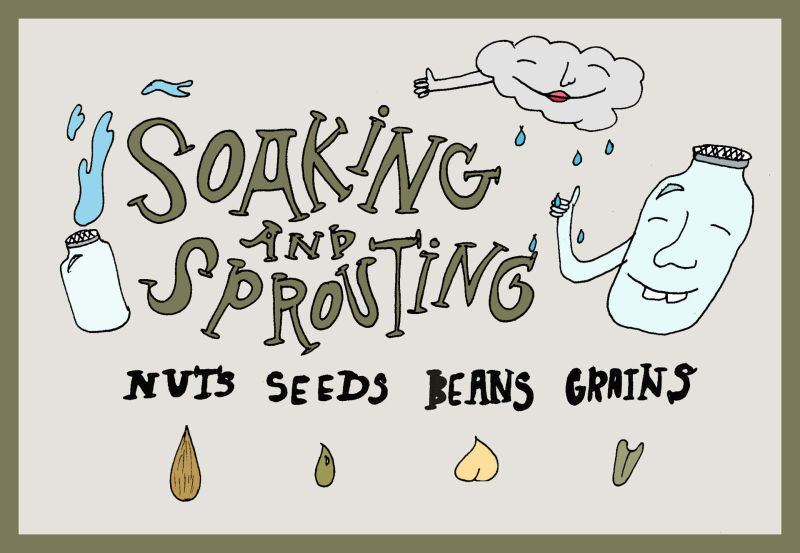I look out my window on a classic foggy Bay Area morning and see a family of deer chomping on some recently planted baby kale peaking its head out of the earth. “ Nooooooo!” I yell as I burst out of my door and shoo the deer away. Since that incident, I have taken a little hiatus on growing food in my backyard and have focused on the garden I can grow inside my kitchen.
My newest food adventure has been sprouting nuts, seeds, beans, and grains. Beans, nuts, seeds and whole grains contain phytic acid, a compound that inhibits the body from absorbing nutrients and minerals. Most people don’t realize the importance of soaking your legumes and grains before you eat or cook them to break down the phytic acid and other anti-nutrients to make them more digestible. The soaking process is extremely simple; all you need to do is soak your nuts, seeds, beans or grains in water for the appropriate amount of time. (See Soaking & Sprouting Times chart in this post below.)
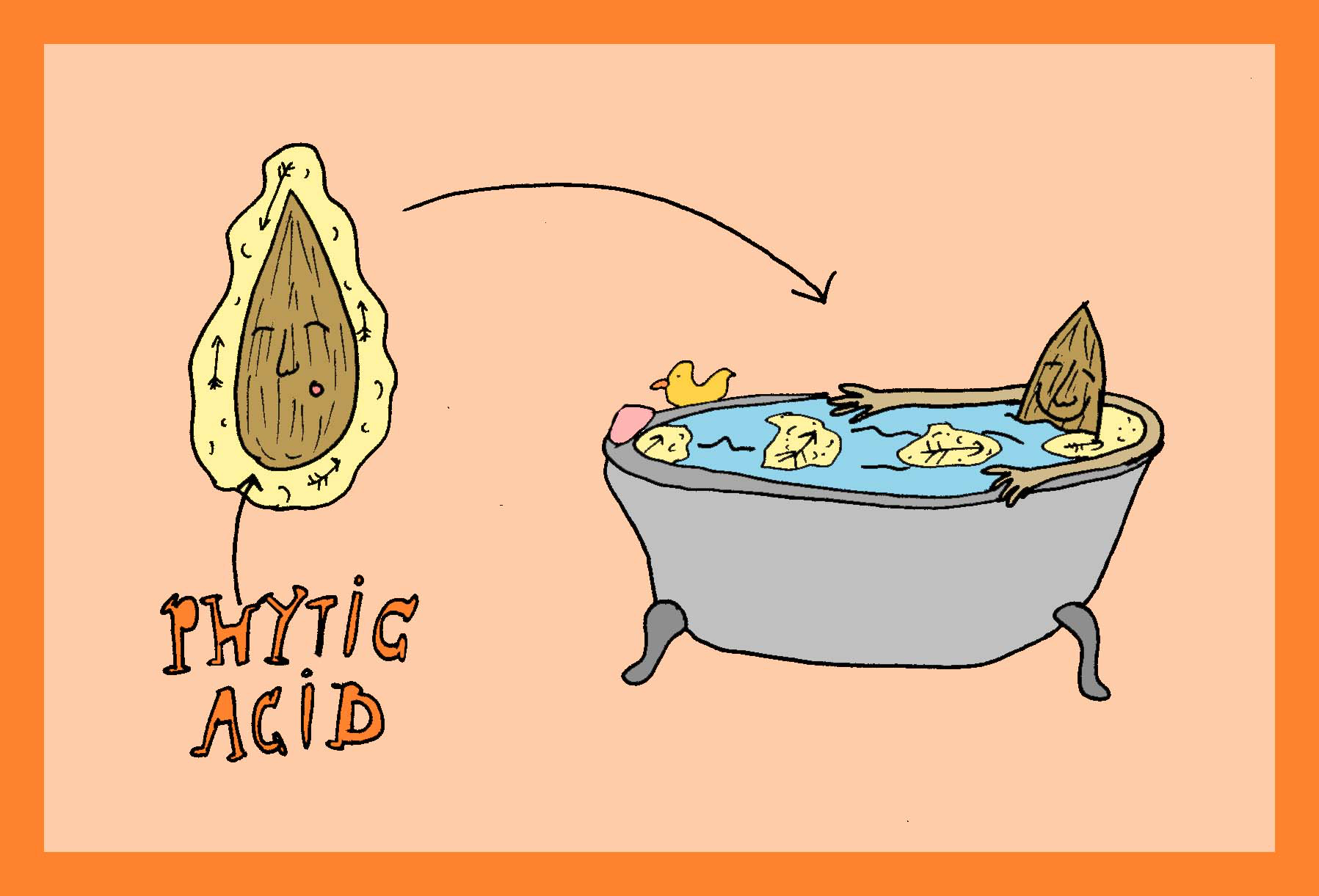
Soaking simulates “rain” that tells the legumes, grains and seeds that it is time to come out and grow. You can either choose to soak these foods and consume them or continue along on the journey to sprouting.
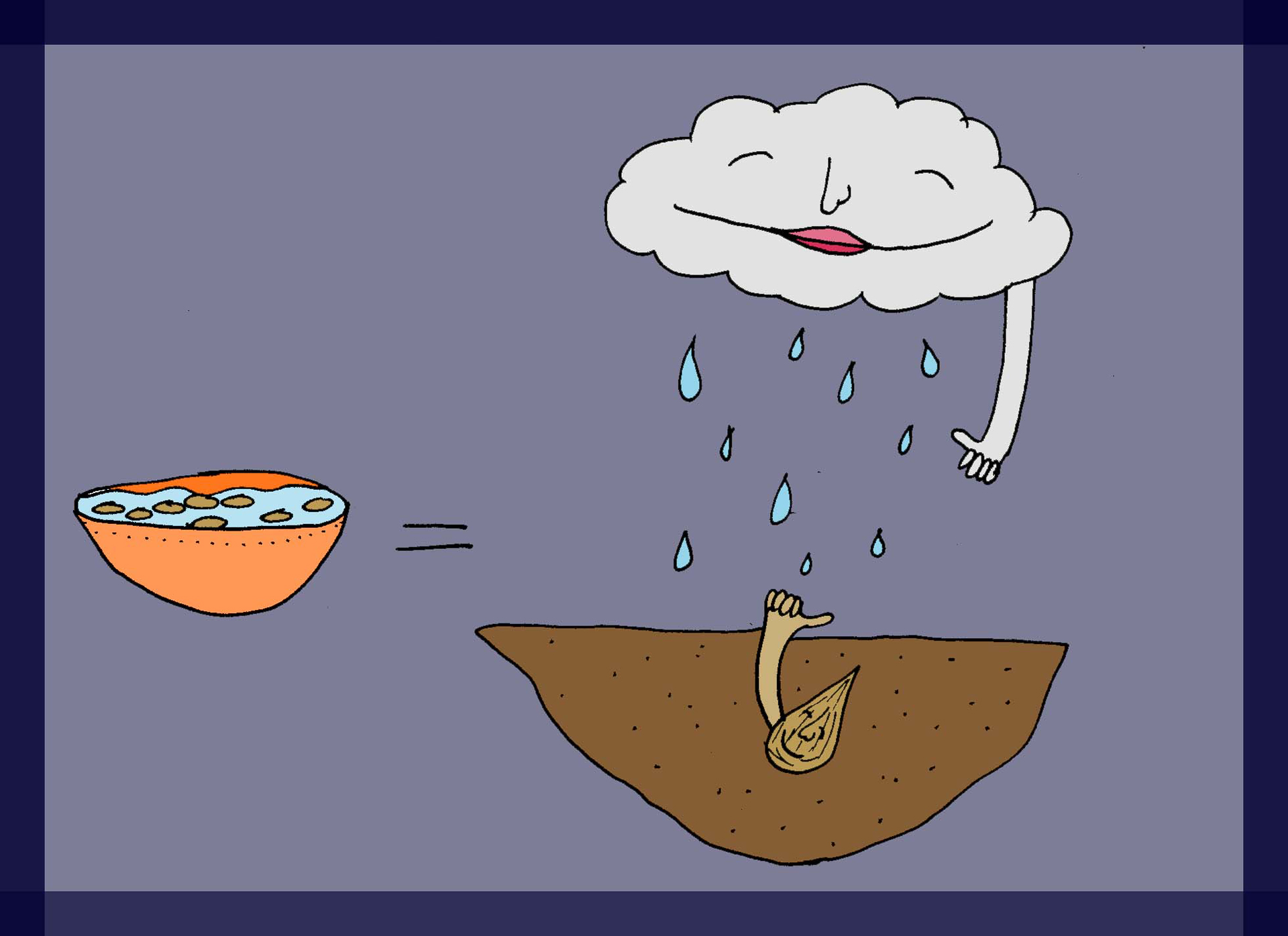
Sally Fallon, in her book Nourishing Traditions, speaks to modern-day eaters about what they can learn about healthy eating from the traditional diets of our ancestors. The Chinese were the first people to sprout beans as they sailed on voyages overseas. It was the vitamin C in sprouted mung beans that prevented the crew from getting scurvy. The instructions to sprout dried peas for soups were found in old French cookbooks and the popular Middle Eastern grain, bulgur, is made from sprouted wheat. Our ancestors all over the world were aware of the benefits of eating live foods and Fallon gives an excellent overview of why it is beneficial for 21st century eaters to soak and sprout their legumes, grains and seeds.
“The process of germination not only produces vitamin C but also changes the composition of grains and seeds in numerous beneficial ways. Sprouting increases vitamin B content, especially B2, B5, and B6. Carotene increases dramatically–sometimes eightfold. Even more important, sprouting neutralizes phytic acid, a substance present in the bran of all grains [and in legumes and seeds] that inhibits absorption of calcium, magnesium, iron, copper and zinc; sprouting also neutralizes enzyme inhibitors present in all seeds. These inhibitors can neutralize our own precious enzymes in the digestive tract…Finally, numerous enzymes that help digestion are produced during the germination process."
Here is where you get to choose your own soaking and sprouting adventure.
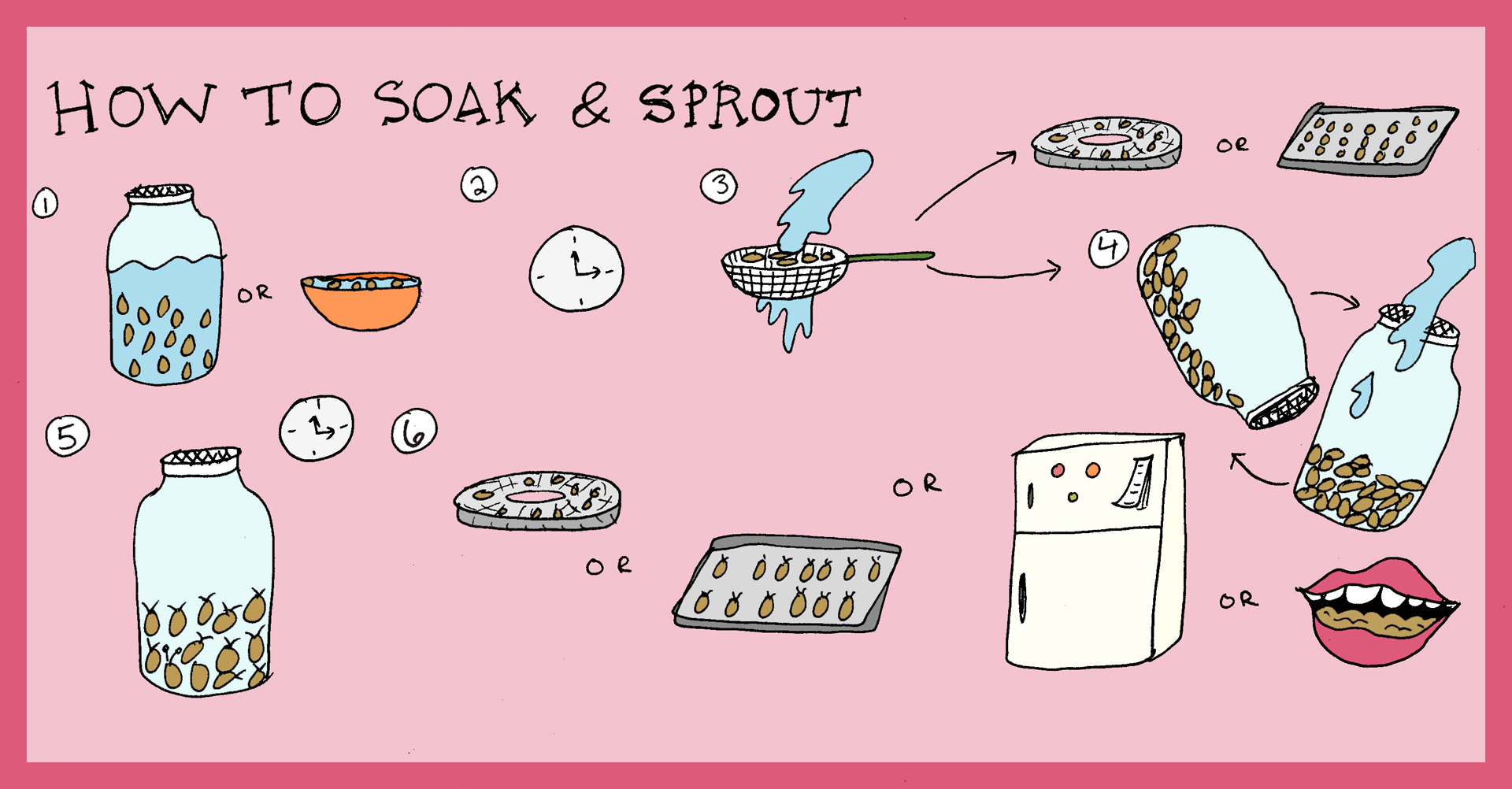
- Soak your legumes/grains/seeds. Put your legumes/grains/seeds in a glass bowl or half-gallon canning jar and cover with twice as much filtered water as your nuts and seeds or beans. (So for one cup of almonds cover with two cups of filtered water.)
* Optional: add 1 TBS of apple cider vinegar OR ½ TBS of salt for every 2 cups of nuts/seeds/beans to help breakdown the phytic acid. - Wait and let your legumes/grains/seeds soak for the appropriate amount of time. (See Soaking & Sprouting Times chart in this post below.)
- Rinse your soaked legumes/grains/seeds until the water runs clear. You can either use a strainer or sprouting jar lid.
Here is where you can choose to stop your journey or continue down another path. Now that your legumes/grains/seeds have been soaked you can dehydrate them in a dehydrator (at 120 degrees overnight) or in an oven at lowest setting (170 degrees) for about 12 hours or until completely dry. If you are using nuts you could also proceed to make your own nut milk and then use the pulp to make granola. Or if you are making beans, you can cook them right away and eat them. Note that sprouted beans take less time to cook. - Sprout! Take your soaked legumes/grains/seeds and place them in a jar with a sprouting lid face down in your dish rack. This allows the excess water to drain off and the air to circulate so that the legumes/grains/seeds can grow. Shift yourself into caretaking mode because you need to “water your indoor garden” by rinsing the legumes/grains/seeds several times a day (at least twice). See the chart below for sprouting times.
- Grow. As you continue to rinse your legumes/grains/seeds you will notice a white or green tail start to grow. That means they have sprouted!
- Store. Keep your sprouts in the fridge for 3-4 days or dehydrate them.
Important note! Sprouts are at risk for contamination, which can result in bacterial growths, such as E. coli leading to foodborne illnesses. Always purchase organic fresh products from a reliable source, wash your hands thoroughly before handling foods, and keep sprouting jars and all kitchen surfaces clean to avoid cross contamination. Always consume sprouts within a few days, fresh and straight out of the fridge.
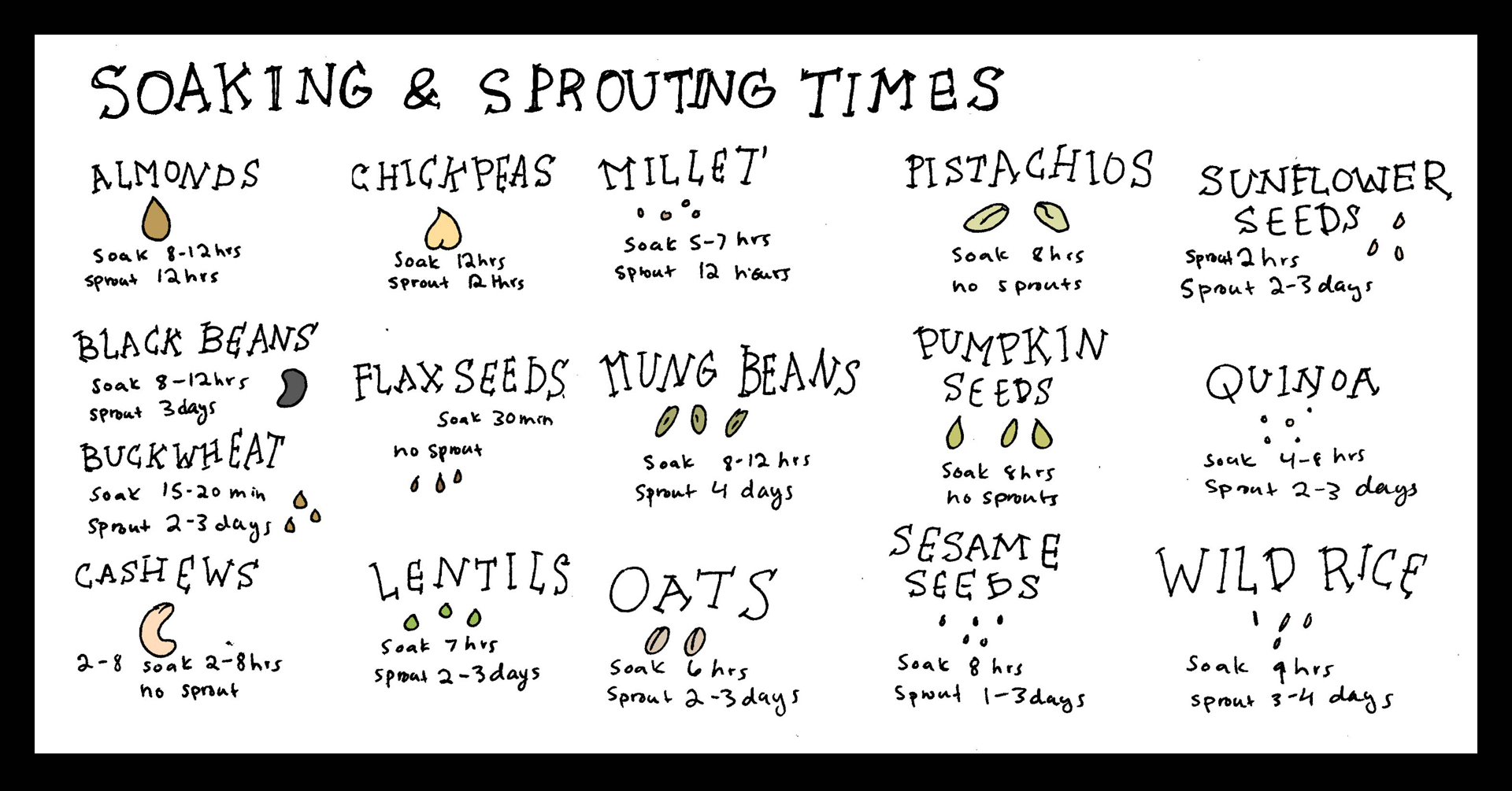
As the sun goes down on a summer night I stand in my kitchen and pop a sprouted almond into my mouth. Looking out into my yard, sure enough, there is the family of deer relaxing in the grass. I make eye contact with the Mama deer and raise a sprouted almond to her, “this time these are for me.”

-
Resources:
- Nourishing Traditions: The Cookbook that Challenges Politically Correct Nutrition and the Diet Dictocrats by Sally Fallon, Mary G. Enig, Ph.D (amazon.com)
- Guide to Soaking and Sprouting (nutritionstripped.com)
- REAL FOOD 101: How to Soak, Sprout, and Dehydrate Nuts, Beans, and Seeds (ournourishingroots.com)
- Your Guide To Soaking & Sprouting Whole Grains, Beans, Nuts, & Seeds (weedemandreap.com)
